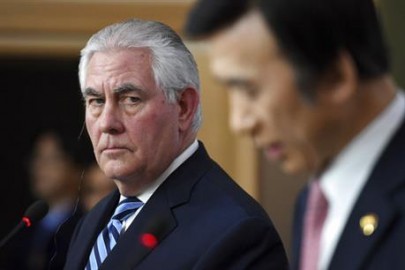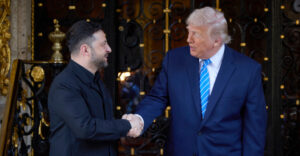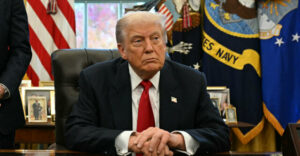The United States signaled a tougher strategy toward North Korea on Friday that leaves open the possibility of pre-emptive military action and rejects talks with the communist nation until it gives up its weapons of mass destruction.
“Let me be very clear: the policy of strategic patience has ended,” said Secretary of State Rex Tillerson. “We are exploring a new range of diplomatic, security and economic measures. All options are on the table.”
Tillerson was speaking after visiting the heavily militarized border between the rival Koreas. His comments are likely to displease Beijing, where he travels this weekend. China has been advocating diplomacy to avoid a conflict on the divided peninsula.
Also Friday, President Donald Trump tweeted: “North Korea is behaving very badly. They have been ‘playing’ the United States for years. China has done little to help!”
Past U.S. administrations have considered military options against North Korea and have publicly said that an attack on the U.S. or its allies would prompt a devastating response.
Tillerson’s comments were unusual, however, as he appeared to be implying, in public, that the U.S. would consider military force as a way of preventing an attack by Pyongyang, and not just as a means of retaliation. It also comes amid a greater sense of urgency about the threat because of North Korea’s rapid progress toward developing the means to strike the U.S. with a nuclear-tipped missile. Risks of military action are high as North Korea could unleash a massive artillery barrage on Seoul in retaliation.
The Trump administration says it is conducting a review of North Korea policy. At a news conference in Seoul, alongside his South Korean counterpart Yun Byung-se, Tillerson said U.S was exploring the new range of diplomatic, security and economic measures and emphasized that Obama administration’s policy of “strategic patience”— that saw tightening of sanctions to try and get North Korea back to negotiations aimed at denuclearization — had ended.
Asked about the possibility of using military force against North Korea, he said, “all of the options are on the table.”
Tillerson said the U.S. does not want a military conflict, “but obviously if North Korea takes actions that threaten South Korean forces or our own forces that would be met with (an) appropriate response. If they elevate the threat of their weapons program to a level that we believe requires action that option is on the table.”
Former members of the Clinton administration have said that the U.S. considered a strike on a North Korean nuclear facility in 1994 when it appeared on the brink of producing weapons-grade fissile material and refused U.N. inspections. A diplomatic deal was struck to avert conflict.
Since then, North Korea has violated multiple U.N. Security Council resolutions and has been undeterred by tough international sanctions. The North conducted two nuclear test explosions and 24 ballistic missile tests last year. Last week, after the U.S. and South Korea began annual military drills that the North views as rehearsal for invasion, it test-fired four missiles into seas off Japan.
Central to the U.S. review is China and its role in any bid to persuade Pyongyang to change course. China remains North Korea’s most powerful ally and dominant trading partner. China recently announced it was suspending coal imports that are an important source of revenue for North Korea for the rest of the year in adherence with U.N. sanctions.
Tillerson urged China and other countries to fully implement the sanctions. He criticized China’s opposition to a U.S. missile defense system being deployed in South Korea and accused it of waging “inappropriate and troubling” economic retaliation against the South. China sees the system as a threat to its own security although the U.S. says it is only targeted against North Korea. Tillerson said China should focus on the North Korean threat that makes the deployment necessary.
Tillerson also rejected Beijing’s proposal of halting the U.S.-South Korean military drills in exchange for a nuclear freeze by North Korea. He said the allies had no intention to stand down the exercises that are defensive in nature and conducted transparently, unlike North Korean missile launches. He further sounded skeptical about the idea of negotiating a freeze that would leave the North with “significant capabilities” that could threaten the region and U.S. forces.
The U.S. retains nearly 30,000 troops in South Korea, and nearly 50,000 in neighboring Japan.
More broadly, Tillerson poured cold water on the idea of resuming negotiations with Pyongyang, saying, “20 years of talks with North Korea have brought us to where we are today.”
“It’s important that the leadership of North Korea realize that their current pathway of nuclear weapons and escalating threats will not lead to their objective of security and economic development. That pathway can only be achieved by denuclearizing, giving up their weapons of mass destruction, and only then will we be prepared to engage with them in talks,” he said.
Six-nation aid-for-disarmament talks with North Korea, which were hosted by China, have in fact been stalled since 2009. The Obama administration refused to resume them unless the North re-committed to the goal of denuclearization, something it has shown little interest in doing.
Earlier Friday, Tillerson touched down by helicopter at Camp Bonifas, U.S.-led U.N. base about 400 meters (438 yards) from the Demilitarized Zone, a Cold War vestige created after the Korean War ended in 1953. He then moved to the truce village of Panmunjom inside the DMZ, a cluster of blue huts where the Korean War armistice was signed. He is flying this week without the usual contingent of journalists who normally cover the secretary of state.
Tillerson is the latest in a parade of senior U.S. officials to have their photos taken at the border. But it was the first trip by the new Trump administration’s senior diplomat.
The DMZ, which is both a tourist trap and a potential flashpoint, is guarded on both sides with land mines, razor wire fence, tank traps and hundreds of thousands of combat-ready troops. More than a million mines are believed to be buried inside the DMZ. The Korean War ended with an armistice, not a peace treaty, which means the Korean Peninsula remains in a technical state of war.
Ask me anything
Explore related questions





